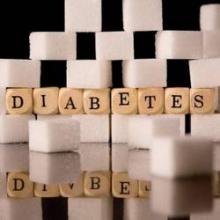Insulin glargine therapy was associated with significantly greater reductions in liver fat burden in patients with type 2 diabetes than was liraglutide, judging from the findings of a prospective randomized controlled trial.
Both treatments significantly improved glycosylated hemoglobin. However, neither led to a significant change in liver fat fraction, as measured with magnetic resonance spectroscopy (MRS), according to a study published online March 26 in Diabetes Care.
Researchers randomized 35 patients, whose type 2 diabetes was inadequately controlled on either metformin monotherapy or combination therapy, to 12 weeks therapy starting with 10 IU of subcutaneous insulin glargine daily or a starting dose of 0.6 mg of subcutaneous liraglutide, titrated to 1.8 mg or the maximal tolerated dose.
Patients on insulin glargine showed significant reductions in MRS-based liver proton density fat fraction (13.8% to 10.6%; P = .005), and MRI-based liver volume (2,010.6 mL to 1,858.7 mL; P = .01) and total liver fat index (304.4 vs. 209.3%; P = .01).
They also showed a trend toward a decreased MRS-based liver proton density fat fraction (12.6% to 9.9%; P = 0.06).
However patients treated with liraglutide showed no significant changes in any of these indexes (Diabetes Care 2015, March 26 [doi:10.2337/dc14-2548]).
While insulin is associated with weight gain and may be lipogenic, previous imaging studies have actually showed a reduction in liver fat with insulin therapy.
“The mechanisms by which insulin therapy may reduce liver fat include inhibition of lipolysis, which may reduce free fatty acid flux to the liver and decreased production of endogenous insulin passing through the liver to stimulate hepatic lipogenesis,” wrote Dr. An Tang, from the University of Montreal, and coauthors.
At the same time, GLP-1 agonists such as liraglutide promote weight loss and were thought to decrease liver fat by increasing fatty acid uptake and very low density–lipoprotein transport.
However, the study failed to find any significant change in biomarkers of liver fat burden among those patients randomized to liraglutide.
“It is possible that the postprandial increase in insulin secretion in the portal circulation and the decrease in glucagon secretion induced by the GLP-1 analogs could favor lipogenesis and therefore explain the lack of effect of liraglutide on hepatic steatosis observed in the current study,” the authors wrote.
The study found that patients taking liraglutide showed a significant reduction in body mass index or BMI (31.3 to 30.1 kg/m2; P = .008) while those on insulin glargine did not (31.2 to 31.3 kg/m2; P = .92).
“Interestingly, the improvement in BMI in patients randomized to liraglutide therapy was not associated with concomitant changes in the liver fat burden,” they wrote.
They noted a similar rate of adverse events in the insulin glargine and liraglutide groups.
The authors said that while the study’s short duration may have worked against liraglutide, because its impact on BMI may have had a longer term impact on liver fat fraction, they argued it was enough to address the primary end point.
“This reduction in liver fat burden on insulin therapy is reassuring and important because many patients with type 2 diabetes and NALFD [nonalcoholic fatty liver disease] have to be treated with insulin to achieve adequate glycemic control,” the authors wrote.
The study was supported by the Radiological Society of North America Research and Education Foundation, and Diabète Québec. Authors reported grants, honorarium, personal fees, and research funds from private industry.


